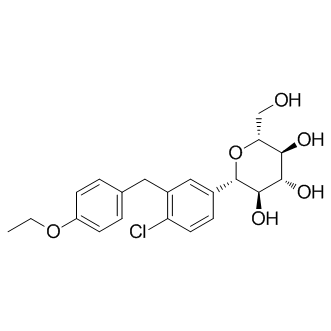DAPAGLIFLOZIN
Cat. No.: DC6904
Featured
Chemical Structure
461432-26-8
We are official vendor of:
More than 5000 active chemicals with high quality for research!
Field of application
Dapagliflozin, also known as BMS-512148, is a drug used to treat type 2 diabetes approved in 2012 by FDA. Dapagliflozin inhibits subtype 2 of the sodium-glucose transport proteins (SGLT2) which are responsible for at least 90% of the glucose reabsorption in the kidney. Blocking this transporter mechanism causes blood glucose to be eliminated through the urine. In clinical trials, dapagliflozin lowered HbA1c by 0.6 versus placebo percentage points when added to metformin.
| Cas No.: |
461432-26-8 |
| SMILES: |
O[C@H]1[C@H](C2=CC=C(Cl)C(CC3=CC=C(OCC)C=C3)=C2)O[C@H](CO)[C@@H](O)[C@@H]1O |
| Formula: |
C21H25ClO6 |
| M.Wt: |
408.87 |
| Purity: |
>98% |
| Sotrage: |
2 years -20°C Powder, 2 weeks 4°C in DMSO, 6 months -80°C in DMSO |
| Description: |
Dapagliflozin (BMS-512148) is a sodium-glucose co-transporter 2 (SGLT2) inhibitor for the treatment of type 2 diabetes. |
| In Vivo: |
At 11 mM glucose, dapagliflozin raises glucagon release from 18% to 32% of control, while the effect of dapagliflozin addition is minor at 1 mM glucose. At the intermediate glucose concentration of 6 mM, glucagon secretion is estimated to be 24% and 30% of control in the absence or presence of dapagliflozin, respectively[1]. Dapagliflozin pretreatment significantly reduces the number of TUNEL-positive cells in IR-injured kidneys. Dapagliflozin pretreatment significantly elevates the HIF1 expression in IR-injured renal tubular cells from mice[2]. Dapagliflozin (10 mg/kg, o.p.) causes a marked increase in urinary glucose in SGLT2i-mice. Dapagliflozin acutely suppresses BAT thermogenesis by reducing sympathetic nerve activity. Dapagliflozin enhances hepatic gluconeogenesis and glycogenolysis[3]. |
| In Vitro: |
Dapagliflozin pretreatment of hypoxic HK2 cells significantly improves the cell viability in a dose-dependent manner. Dapagliflozin decreases Bax expression, the Bax/Bcl2 ratio, and PARP expression in hypoxic HK2 cells[2]. |
MSDS
COA
| LOT NO. |
DOWNLOAD |
|

|
| 2018-0101 |

|
| 2018-0101 |

|
Get Quote






















